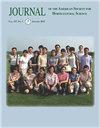The Self-incompatibility Locus and Chloroplast DNA Regions of Prunus domestica Reflect the Origin and Genetic Diversity of Traditional Cultivars
IF 1.1
4区 农林科学
Q3 HORTICULTURE
Journal of the American Society for Horticultural Science
Pub Date : 2023-09-01
DOI:10.21273/jashs05330-23
引用次数: 0
Abstract
A traditional cultivar, Besztercei Bt.2, and a clone of an autochthonous landrace (Nemtudom P3) of the hexaploid European plum ( Prunus domestica ) were studied to highlight their breeding perspectives. Five self-incompatibility ribonuclease ( S-RNase ) alleles were detected in both cultivars, with one allele shared. DNA sequence analysis confirmed it as a new, previously unidentified allele in P. domestica , which we labeled as S 18 . This allele was found to share ∼99% identity with the Prunus spinosa S B - RNase allele. Because Prunus species are readily hybridizing, sequence variations in 10 chloroplast DNA regions and nuclear internal transcribed spacers were studied to check if ‘Nemtudom P3’ and ‘Besztercei Bt.2’ are indeed P. domestica . The majority-rule consensus tree of maximum likelihood and Bayesian inferences confirmed it, and also indicated genetic differentiation with ‘Nemtudom P3’ and ‘Besztercei Bt.2’ forming a statistically supported subclade within the P. domestica germplasm. Our results pointed to some regions of the P. domestica chloroplast genome ( trnS - trnG - trnG , trnC-ycf6 , and trnD - trnT ) that can be used to detect intraspecific variations. The proportion of parsimony informative characters compared with the total length of amplified regions was the highest in the case of nrITS with 12.1%. The S -genotyping of 68 wild-growing Nemtudom trees showed the genetic consequences of long-term vegetative propagation and occasional crossing between Besztercei and Nemtudom accessions. Controlled pollinations confirmed the self-compatibility of ‘Nemtudom P3’. By clarifying their phylogenetic position, and characterizing the S -locus, our results will help breeding P. domestica cultivars and pave the way to understanding how the S -locus works in a hexaploid Prunus species.家李的自交不亲和位点和叶绿体DNA区域反映了传统品种的起源和遗传多样性
以六倍体欧洲李(Prunus domestica)的传统品种Besztercei Bt.2和本地地方品种Nemtudom P3的无性系为研究对象,探讨其选育前景。两个品种均检测到5个自交不亲和核糖核酸酶(S-RNase)等位基因,其中1个等位基因是共有的。DNA序列分析证实该等位基因为家蝇新发现的等位基因,标记为s18。该等位基因与樱S B - RNase等位基因具有99%的同源性。由于李属植物易于杂交,为了验证Nemtudom P3和Besztercei Bt.2是否为家李属植物,我们研究了李属植物10个叶绿体DNA区域和核内转录间隔序列的序列差异。多数规则最大似是似是和贝叶斯推理的共识树证实了这一点,并表明遗传分化与' Nemtudom P3 '和' Besztercei Bt.2 '在家蝇种质资源中形成一个统计支持的亚支系。我们的结果指出了家蝇叶绿体基因组的一些区域(trnS - trnG - trnG, trnC-ycf6和trnD - trnT)可用于检测种内变异。简明信息性状占扩增区总长度的比例在nrITS中最高,为12.1%。对68株野生猫兔树的S -基因分型分析表明,长时间无性繁殖和间或杂交对猫兔树的遗传影响。控制授粉证实了‘Nemtudom P3’的自亲和性。通过澄清它们的系统发育位置和S -位点的特征,我们的研究结果将有助于培育家蝇品种,并为了解S -位点在六倍体李树物种中的作用机制铺平道路。
本文章由计算机程序翻译,如有差异,请以英文原文为准。
求助全文
约1分钟内获得全文
求助全文
来源期刊
CiteScore
3.80
自引率
0.00%
发文量
31
审稿时长
2 months
期刊介绍:
The Journal of the American Society for Horticultural Science publishes papers on the results of original research on horticultural plants and their products or directly related research areas. Its prime function is to communicate mission-oriented, fundamental research to other researchers.
The journal includes detailed reports of original research results on various aspects of horticultural science and directly related subjects such as:
- Biotechnology
- Developmental Physiology
- Environmental Stress Physiology
- Genetics and Breeding
- Photosynthesis, Sources-Sink Physiology
- Postharvest Biology
- Seed Physiology
- Postharvest Biology
- Seed Physiology
- Soil-Plant-Water Relationships
- Statistics

 求助内容:
求助内容: 应助结果提醒方式:
应助结果提醒方式:


